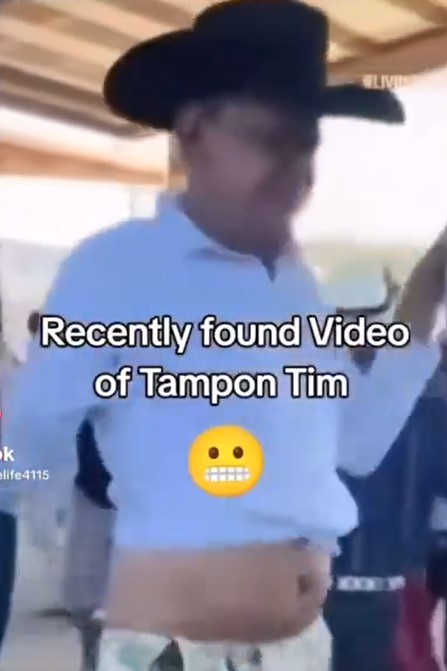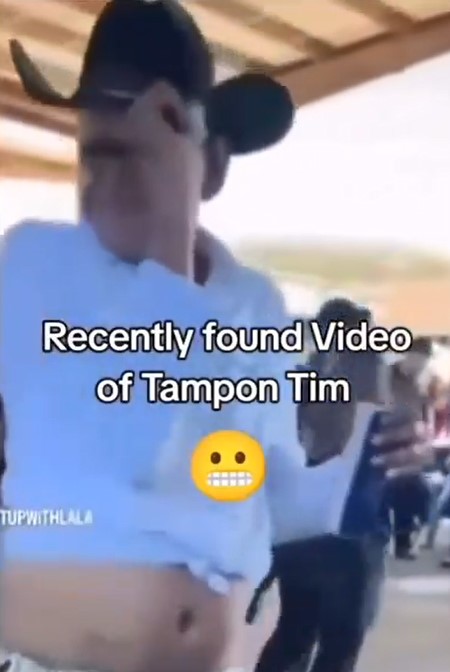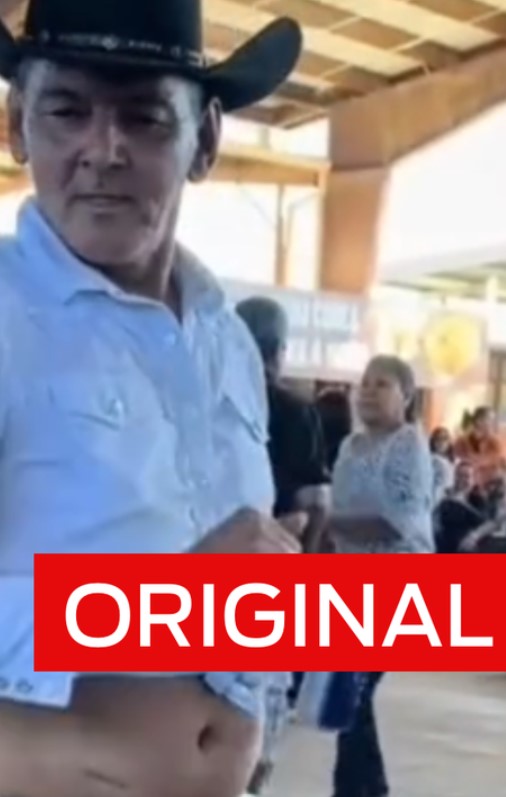Tim Walz Dance Video and Facts Behind the Viral Sensation
In recent weeks, a video has rapidly circulated across social media platforms, purportedly showing Tim Walz, the US Democratic vice presidential candidate, engaged in a rather unorthodox dance. The clip, often referred to as the Tim Walz dance video, features an individual supposedly Walz dancing with a cowboy hat, his shirt whimsically tied up to expose his midriff, and dollar bills provocatively tucked into his jeans’ waistband. This visual spectacle is accompanied by derogatory text overlays, including nicknames like “Tampon Tim,” aimed to ridicule.
The emergence of this video has sparked a flurry of shares and comments, with many viewers quick to pass judgment. Social media users, drawn by the sensational nature of the content, have variously expressed amusement, disbelief, and indignation, contributing to the video’s viral spread. This rapid dissemination highlights the powerful role of social media in shaping public perception, particularly concerning political figures.
However, this immediate reaction to the video often overlooked a crucial aspect: the authenticity of the content. Preliminary investigations by several fact-checking organizations have suggested that the video may not be what it appears. As the clip gained more attention, these groups began to scrutinize the details of the video, leading to some surprising revelations about its origin and the identity of the person depicted. This situation underscores the challenges and potential pitfalls of the digital age, where the line between reality and manipulation can be both thin and perilously misleading.
| Element | Description |
|---|---|
| Subject of the Video | Tim Walz, US Democratic vice presidential candidate, engaged in an unorthodox dance. |
| Video Description | Dance with a cowboy hat, shirt tied up to expose midriff, dollar bills in jeans’ waistband, derogatory text overlays like “Tampon Tim.” |
| Public Reaction | Amusement, disbelief, and indignation, contributing to viral spread. |
| Social Media’s Role | Highlighted as a powerful tool in shaping public perception of political figures. |
| Authenticity Concerns | Initial overlook of authenticity, later scrutinized by fact-checking organizations revealing potential misleading content. |
Content
Origin and Spread of the dance Video
The controversial video in question depicts a figure, alleged to be Tim Walz currently the US Democratic vice presidential candidate engaging in a dance that seems both unconventional and out of character for a person of his stature. In the video, the individual wears a cowboy hat, and his shirt is knotted high on his chest, revealing his midriff. Additionally, several dollar bills are visibly tucked into the waistband of his jeans, an imagery often used in media to suggest impropriety or revelry. The person spins joyously around a dance floor, seemingly carefree and oblivious to the potential political consequences of such a display.
The Tim Walz dance video shocks everyone when they realize it is not actually Tim Walz
This video was not merely shared; it was embellished with text overlays and hashtags that intensified the spectacle. A particularly striking overlay read “Recently found Video of Tampon Tim,” a pejorative moniker, with the hashtag “#weird” also superimposed over a white box that seemed to obscure another hashtag. These additions were clearly designed to demean and provoke shock, further detaching the figure in the video from the dignified image typically associated with a vice presidential candidate.
The platforms that facilitated the rapid spread of this video include major social media networks like Facebook, Twitter, and particularly TikTok, where the clip gained significant traction. The nature of these platforms, coupled with the algorithms that prioritize engaging content, propelled the video into viral status quickly. Users, attracted by the bizarre and humorous portrayal of a political figure, shared and re-shared the clip, often without questioning its authenticity.
| Element | Description |
|---|---|
| Subject | Tim Walz, US Democratic vice presidential candidate |
| Video Description | Unconventional dance, cowboy hat, shirt knotted at the chest, dollar bills in jeans, carefree demeanor |
| Implied Significance | Suggests impropriety or revelry through attire and actions |
| Added Elements | Text overlays and hashtags like “Recently found Video of Tampon Tim” and “#weird” |
| Distribution Platforms | Facebook, Twitter, TikTok |
| Impact | Video went viral due to engagement on social media, humorous portrayal led to widespread sharing |
Investigating the Authenticity
The viral nature of the video soon attracted the scrutiny of several fact-checking organizations, determined to ascertain the truth behind this seemingly scandalous clip. Among these, AAP FactCheck took the lead, conducting a thorough investigation into the origins of the video. Their research led them to an unaltered version of the video, originally posted on TikTok on August 2, 2024. This discovery was pivotal in unveiling the reality behind the viral sensation.
The unaltered TikTok video revealed that the person in the video was not Tim Walz, but rather Alejandro Casas, known by his pseudonym El Divo 956. Casas is an individual who frequently shares videos of himself dancing in various outfits on his social media accounts, particularly on Facebook. This finding highlighted the deceptive nature of the altered video, where Walz’s face had been superimposed onto Casas’s body using sophisticated editing techniques. Further examination of Casas’s account showed additional clips of him dancing in different attire, none of which bore any resemblance to the attire or demeanor of Tim Walz.
The fact-checking efforts did not stop at identifying the original subject of the video but also involved dissecting the technical aspects of how the alteration was achieved. This analysis was crucial in demonstrating the ease with which digital content can be manipulated for political or sensational purposes. The debunking of the video by reputable sources such as USA Today, Logically Facts, and Reuters followed shortly, providing the public with factual corrections to the misleading narrative that had been so quickly embraced.
The case of the misrepresented dance video serves as a stark reminder of the potent mix of technology and social media in shaping public perceptions often at the expense of truth. The efforts of these fact-checking organizations are essential in maintaining a semblance of reality in the increasingly digital and manipulated landscape of modern media. As this incident illustrates, the authenticity of viral content must always be questioned, particularly when it pertains to figures of significant public interest and political standing.
| Element | Description |
|---|---|
| Fact-Checking Organizations | AAP FactCheck led the investigation to ascertain the truth behind the video. |
| Discovery | Found an unaltered TikTok video from August 2, 2024, revealing the actual person as Alejandro Casas, not Tim Walz. |
| Real Identity | Alejandro Casas, known as El Divo 956, often posts dance videos on Facebook. |
| Deceptive Nature of Video | Walz’s face was superimposed onto Casas’s body using advanced editing techniques. |
| Fact-Checking Analysis | Technical analysis of how the video was altered, demonstrating the ease of digital manipulation. |
| Debunking | Video debunked by sources like USA Today, Logically Facts, and Reuters, correcting the misleading narrative. |
| Lesson | Highlights the impact of technology and social media in shaping public perceptions, underscoring the need for vigilance regarding the authenticity of viral content. |
Unveiling the Truth
Alejandro Casas, also known by his stage name El Divo 956, is a vibrant social media personality known for his enthusiastic dance videos. Casas frequently shares content across platforms like Facebook and TikTok, where he enjoys a modest following. His videos, characterized by exuberant dancing and a variety of colorful outfits, starkly contrast the serious demeanor often expected of political figures like Tim Walz. The video that mistakenly implicated Walz was, in fact, a playful and innocent clip from Casas’s personal collection.
The technical manipulation of the video involved sophisticated digital editing techniques. The process, known as deepfaking, involves using artificial intelligence and machine learning to replace one person’s face with another in video content. This technology can create highly convincing and yet entirely fictional video content. In this case, Casas’s face was digitally replaced with that of Tim Walz’s, turning an innocuous personal video into a tool of misinformation.
Reputable fact-checking organizations quickly stepped in to clarify the situation. USA Today reported, “A thorough analysis confirms the video is a deepfake, inaccurately portraying Walz in activities never undertaken by him.” Similarly, Logically Facts noted, “Our investigation reveals the video as a classic example of digital impersonation, intended to mislead.” Reuters added, “Experts confirm the man originally featured in the viral dance video is not Tim Walz but a social media dancer, misrepresented through advanced editing tools.”
| Element | Description |
|---|---|
| Alejandro Casas (El Divo 956) | Social media personality known for vibrant dance videos on Facebook and TikTok, contrasting with political figures like Tim Walz. |
| Nature of the Video | Playful, innocent clip from Casas’s personal collection, featuring exuberant dancing and colorful outfits. |
| Technical Manipulation | Sophisticated digital editing via deepfaking; AI and machine learning used to superimpose Walz’s face onto Casas’s video. |
| Fact-Checking Response | Organizations like USA Today, Logically Facts, and Reuters confirm the video as a deepfake, clarifying the misrepresentation. |
The Impact of Misinformation
This incident is not isolated. Since being named as Kamala Harris’s running mate, Tim Walz has been the subject of several false claims. These range from bizarre allegations of inappropriate behavior to unfounded accusations regarding changes to state symbols to reflect foreign influences. Such misinformation not only distorts public perception of Walz but also undermines the integrity of democratic processes by spreading confusion and distrust.
The broader implications of such misinformation are profound. Political figures face an ever-increasing risk of being targeted by false narratives, which can alter public opinion and potentially influence electoral outcomes. Misinformation can erode trust in not only individual politicians but also in the political system as a whole, leading to disengagement and skepticism among voters.
Experts in digital media and political science emphasize the dangers of misinformation. Dr. Emily Van Der Nagel, a social media researcher, explains, “The ease with which digital content can be manipulated makes it imperative for the public to critically evaluate the credibility of online information.” Political analyst Jameson Drew offers a similar warning: “Misinformation, if left unchecked, can quickly become accepted as truth, shaping voter behavior based on falsehoods.”
In conclusion, the case of the misrepresented dance video serves as a critical reminder of the challenges posed by digital misinformation in today’s media landscape. For democracy to function effectively, it is essential that both the public and platforms commit to distinguishing between genuine and manipulated content, thereby safeguarding the truth and maintaining trust in our public institutions.
| Element | Description |
|---|---|
| Subject | Tim Walz, Kamala Harris’s running mate, targeted by several false claims and misinformation. |
| Nature of Misinformation | Allegations range from inappropriate behavior to unfounded accusations affecting public perception and trust. |
| Impact on Democracy | Misinformation undermines democratic integrity, influencing public opinion and electoral outcomes, leading to voter disengagement and skepticism. |
| Expert Opinions | Dr. Emily Van Der Nagel and Jameson Drew highlight the ease of digital manipulation and the dangers of misinformation shaping voter behavior. |
| Call to Action | Emphasis on the need for public and platforms to critically evaluate and distinguish between genuine and manipulated content to protect democracy. |
The incident involving the viral video falsely depicting Tim Walz highlights the pivotal role of fact-checking in the digital age. Through diligent investigation, organizations like AAP FactCheck, USA Today, Logically Facts, and Reuters were able to trace the original content to Alejandro Casas, debunking the misleading claims associated with the video. Their efforts underscore the importance of verifying digital content, especially when it involves public figures or sensitive topics.
This situation serves as a crucial lesson in media literacy, particularly during election seasons when the spread of misinformation can have significant consequences. Viewers and readers are urged to approach viral videos and sensational claims with a healthy dose of skepticism. Before sharing content, it is essential to consider its source, verify the information through credible channels, and reflect on the potential impact of spreading unverified information.
Moreover, social media platforms and users alike have a responsibility to foster an environment where truth prevails. Encouraging critical engagement with media, supporting fact-checking initiatives, and educating the public about the signs of manipulated content are vital steps towards this goal.
As election seasons continue to heat up, the integrity of our democratic processes depends not only on the actions of candidates and officials but also on how well the public can navigate the murky waters of misinformation. By prioritizing critical consumption of media, individuals can contribute to a more informed and less polarized political landscape.
Daily Hot News -Gabriela Lima Santana Video and Investigation
Georgia School Shooting Video and Community Response
Jaden Newman Video Leak on X/Twitter and Reddit
Rock Paper Scissors Yellow Dress Video Leak
Yes King Original Video on Meme Culture
YSL Woody Fan Bus Video Leak
Georgie Cooper Video Leak and Public Reaction



